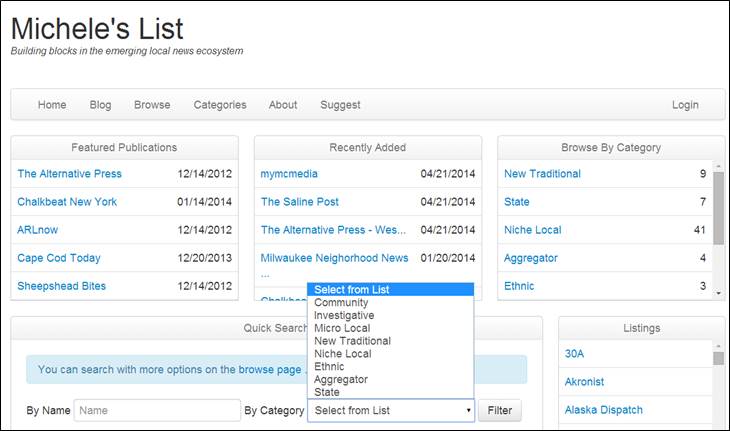

News Start Ups Don’t Spend Enough on Making Money
Online local news start ups are devoting significantly more resources to creating content than they are to raising money to pay for it – and that may spell trouble for long term sustainability.
 That’s one finding from a new survey conducted earlier this year as part of my database of U.S. news start ups, www.micheleslist.org. About 80 publishers responded to the annual survey, which I conduct independently.
That’s one finding from a new survey conducted earlier this year as part of my database of U.S. news start ups, www.micheleslist.org. About 80 publishers responded to the annual survey, which I conduct independently.
Not all of them answered every question so the number of responses varies.
The survey also showed that local sites are highly dependent on unpaid volunteers. More than a third of the publishers reported they do not draw a salary from their site; more than half rely to some extent on unpaid content contributors; and about a quarter rely on volunteers for sales or other revenue development efforts.
Forty-eight publishers provided information about how they expend their resources. On average, they devoted more than half to editorial content, but less than one-fifth to sales, marketing and other revenue development efforts. The rest went to tech or administrative expenses.
Ideally, the amount of resources devoted to development should be roughly equal to the amount devoted to editorial. Some sites start with a heavy focus on editorial to build audience and then use new revenue to grow their development efforts. As I reported earlier, most publishers in the survey reported revenue growth. But they may not be plowing that money back into the revenue side. The amount devoted to revenue efforts, 18 percent, is the same as it was in my survey a year earlier.
One exception is City Limits, a nonprofit news organization in New York City, which devotes about 45 percent of its resources to revenue development compared to 35 percent to editorial. City Limits reported annual revenue in the $251,000-500,000 range.
With a three-person staff, City Limits has a more balanced approach than most of the sites in the survey. One person is focused on editorial, a second on revenue and a third person on audience development, according to Jarrett Murphy, the executive editor and publisher, who focuses on editorial working with freelance writers.
Murphy said the model evolved as the organization downsized as it became independent of a parent nonprofit, ceased publication of a print magazine, and experienced turnover.
“With only three people, this is kind of how things had to break down,” Murphy said in an email. He added that he fears the composition is short-changing the editorial side. Murphy said the new structure reflects both site needs and the strengths of the three employees.
There is a fine line between spending enough on development to make your editorial product valuable, and choking off the editorial side so much you don’t have enough editorial product to sell. We may be straying toward the latter pole.”
Murphy said he had another hire to make, it would be on the editorial side.
On the for-profit side, Baristanet stood out for a more balanced allocation of expenditures, with about a third of resources devoted to editorial, about a third to revenue development and the rest split between tech and administration.
Liz George, Baristanet’s editor and co-owner, said the site keeps expenditures balanced with a heavy reliance on freelance writers and an ad sales person who receives a 20 percent commission but no pay.
“Everyone is a freelancer. There is no salaried staff,” George said. Baristanet also reported annual revenue in the $251,000-500,000 range.
Here are additional results from the survey:
EXPENSES
Of your total expenses, approximately what percentage went for: (48 responses)
Content/editorial – 55%
Sales, revenue development, marketing – 18%
Technology – 13%
Administration – 9%
Do you (publisher or editor) draw a salary from the site? (76 responses)
Full-time – 38%
Partial – 25%
None – 37%
Three-fourths of those who do not draw a salary operate sites that bring in revenue of $50,000 or less. Nearly all of those who draw only a partial salary operate sites that bring in revenue of $100,000 or less. Those that draw a full salary reported a mix of revenue totals.
CONTENT CONTRIBUTORS (79 responses)
Content for the site comes primarily from (select up to two):
Professional journalists – 81%
Community members who are not journalists – 75%
Partner organizations – 14%
Students – 11%
People who contribute to the site are usually (select up to two):
Full time, paid – 41%
Part time or freelance, paid – 68%
Interns, paid – 13%
Interns working for acadmic credit – 11%
Unpaid – 44%
(Note: Because some sites have more than one payment model and many have both full-time and part-time workers, percentages total more than 100.)
SALES & DEVELOPMENT (71 responses)
How are revenue development/sales people compensated?
Paid, with commission – 11%
Paid, no commission – 37%
Commission only – 32%
Volunteer – 25%
Are revenue/sales people full time or part time?
Full time – 48%
Part time – 68%
 Michele McLellan is a writer, editor, and consultant who works on projects that help strengthen the emerging local news ecosystem. She is the senior programming consultant for Knight Digital Media Center, based at the University of Southern California Annenberg School for Communication & Journalism. This story originally appeared on the Knight Digital Media Center website and is reprinted with permission.
Michele McLellan is a writer, editor, and consultant who works on projects that help strengthen the emerging local news ecosystem. She is the senior programming consultant for Knight Digital Media Center, based at the University of Southern California Annenberg School for Communication & Journalism. This story originally appeared on the Knight Digital Media Center website and is reprinted with permission.









